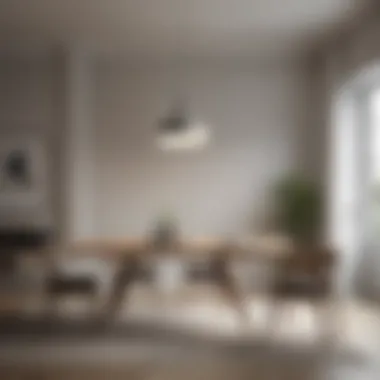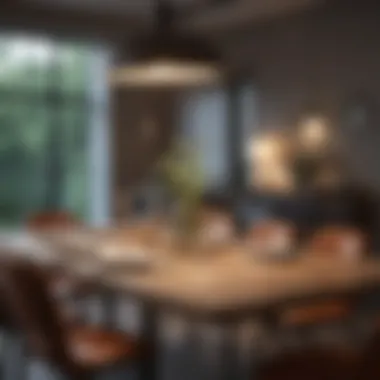Exploring Contemporary Trends in Dining Tables


Intro
Dining tables have evolved beyond mere surfaces for meals. In contemporary design, they serve as focal points, blending functionality and aesthetics. As homes accommodate diverse lifestyles, trends in dining tables reflect an amalgamation of personal taste, practicality, and modern influences. This investigation brings attention to the materials, shapes, and styles emerging in current interiors. Additionally, lifestyle shifts and sustainability considerations play significant roles in shaping choices in dining tables. Readers can gain insight into making informed and stylish selections by exploring these aspects.
Design Inspirations
Trending Styles
The dining table can embody various styles, ranging from minimalist elegance to intricate craftsmanship. Notable trends currently emerge, such as:
- Mid-Century Modern: Characterized by clean lines and organic forms, this style focuses on natural materials like walnut and teak. It’s visually appealing while promoting a sense of openness.
- Industrial: Featuring raw materials such as metal and reclaimed wood, this style evokes an urban feel. It usually incorporates bold designs that fuse vintage with modern elements.
- Scandinavian: This style emphasizes simplicity and functionality. Light colors and sustainable resources create a calm atmosphere, aligning with minimalist living principles.
- Farmhouse: With its rustic charm, it often uses distressed wood and larger sizes, ideal for gatherings. It presents a welcoming vibe, making it suitable for family-oriented spaces.
The choice of style impacts not only the dining table’s appearance but also how it interacts with other elements of a home.
Color Palettes
Color can influence the mood of a dining area substantially. Contemporary trends lean towards neutral and earthy tones, creating a balanced and inviting space.
Some prevalent color palettes include:
- Greys and Whites: Adds a touch of sophistication, working well in modern designs.
- Warm Neutrals: Hues like beige or taupe create cozy settings.
- Bold Accents: Incorporating colors like deep blues or emerald greens accentuates richness while remaining redeemably sophisticated.
Selecting appropriate colors can enhance the overall ambiance and connect the dining area with the broader interior theme.
"The dining table is not just a piece of furniture; it is the stage for social interactions and moments that forge family bonds."
Maintenance and Upkeep
Seasonal Maintenance Checklist
To sustain the beauty of a dining table, regular maintenance is crucial. Here’s a checklist to keep in mind:
- Seasonal Inspection: Check for scratches, stains, or any signs of wear.
- Protection: Use coasters, placemats, and tablecloths to shield surfaces from heat and moisture.
- Refinishing: Sand and apply finish if necessary to restore the wood's natural sheen.
- Storage: For extendable tables, ensure that leaves are correctly stored and maintained to prevent warping.
Cleaning and Organization Tips
Regular cleaning enhances the lifespan of dining tables. Here are some effective methods:
- Use a soft cloth to wipe down surfaces regularity.
- For spills, act quickly using gentle cleaners suitable for the table's material.
- Organize table accessories like centerpieces or candles to avoid clutter during dining.
Choosing a dining table that aligns with your lifestyle will enhance not only aesthetics but also functionality. This understanding equips homeowners, design enthusiasts, and hosts to make choices reflecting their preferences and needs.
Prelims to Dining Table Trends
Dining tables are more than just functional pieces in a home; they represent the heart of social gatherings and family interaction. Understanding current dining table trends is essential for homeowners, interior design enthusiasts, and anyone who enjoys hosting. The dining table serves as a focal point in a room, often influencing the overall aesthetic and functionality of the space. By acknowledging these contemporary trends, individuals can make more informed choices that reflect their style preferences and lifestyle needs.
Historical Context
The evolution of dining tables can be traced back to ancient civilizations, where they held significant social value. In those times, tables were often made from locally sourced materials, reflecting the culture and resources of the region. During the Middle Ages, dining tables were large and served communal purposes. As time progressed, tables became more ornate and symbolized social status in various cultures.
In modern times, dining tables have shifted from purely utilitarian objects to essential components of interior design. Moving from heavy, traditional styles toward lighter, more versatile designs reflects changes in lifestyle and living spaces. The industrial revolution brought about new materials and manufacturing processes, leading to increased diversity in designs and forms.
Influence of Social Dynamics
Social dynamics shape our purchasing decisions and preferences for dining tables. As lifestyles evolve, so do the functions tables serve in our homes. The rise of the open concept living space has prompted a demand for tables that blend seamlessly into multifunctional areas. People are looking for versatility; thus, tables that can accommodate large gatherings or transform into smaller configurations are favored.
Moreover, the pandemic has impacted how we view our dining experiences. With a greater focus on home life and intimate gatherings, many are investing in quality dining tables that enhance the at-home dining experience. This shift is not only about the table itself but also its role in fostering connection among family and friends.
"A dining table can greatly influence the atmosphere of a gathering, making it essential to choose one that aligns with personal values and lifestyle choices."
In summary, dining table trends are influenced by an intertwined history, shifts in social dynamics, and evolving personal preferences. By examining these factors, individuals can create dining spaces that reflect their values while remaining functional and stylish.
Popular Materials in Dining Table Design
The choice of materials in dining table design reflects both trends in aesthetics and practical considerations. Materials influence the durability, maintenance, and even the cost of a dining table. As homeowners and design enthusiasts explore options, understanding the characteristics of various materials can significantly enhance their decision-making process.
Wood: A Timeless Choice
Wood has been the traditional choice for dining tables for centuries. It offers warmth and solidity. Various types of wood, from oak to walnut, each bring unique colors and grain patterns, ensuring that no two tables are exactly the same. Durable hardwoods are often favored for their longevity. Additionally, wood can be refinished to restore its natural beauty over time.
When selecting a wooden dining table, one should consider factors such as the type of finish and whether the wood is sustainably sourced. The aesthetic appeal of wood also allows it to blend well in various interiors, making it versatile. Its natural properties help to create an inviting ambiance during meals.


Metal and Glass Combinations
Metal and glass are gaining traction as trendy materials for contemporary dining tables. This combination offers sleek, modern designs that can elevate any dining space. Glass surfaces provide a feeling of spaciousness, which is especially beneficial in smaller dining areas. Metal frames add strength and can support larger spans without needing excessive support legs, keeping the look minimal.
Metal styles can range from matte to shiny finishes, and colors like black or brass can set the tone of the decor. However, glass requires more upkeep to maintain its clarity and shine. Smudges and fingerprints may become visible, so regular cleaning is necessary. Homeowners should weigh the aesthetic advantages against the practical care required.
Sustainable Materials
As environmental awareness increases, sustainable materials are becoming more prevalent in dining table design. Options like bamboo, reclaimed wood, or composite materials made from recycled resources are increasingly popular among conscientious consumers. These materials reduce waste and carbon footprint, contributing to a more eco-friendly lifestyle.
Using sustainable materials does not compromise beauty or functionality. Designers are finding innovative ways to create stylish pieces that prioritize the planet's health. Potential buyers may want to verify the sourcing of these materials to ensure they meet their ethical standards. Incorporating sustainable dining tables is not just a trend; it signifies a shift towards responsible consumption and a commitment to preserving the environment.
"Choosing the right material for your dining table can enhance the space and reflect personal values, whether it is tradition, modernity, or sustainability."
Current Design Aesthetics
In recent years, dining table design has evolved to reflect broader shifts in contemporary aesthetics. The concept of design aesthetics is crucial because it encompasses the visual appeal and functional aspects of furniture within a dining environment. It guides homeowners, interior designers, and hosts in creating spaces that are not only practical but also harmonious and visually engaging. Understanding these trends provides insight into consumer preferences and influences purchasing choices.
Minimalist Trends
Minimalism has gained strong traction in interior design, particularly with dining tables. This aesthetic promotes simplicity, clean lines, and a lack of clutter. Minimalist dining tables are often constructed from high-quality materials such as wood or metal, emphasizing form without excess ornamentation. The focus is on functionality, which resonates increasingly with modern lifestyles.
- Benefits of Minimalism:
- Enhances spatial perception by creating open, airy environments.
- Encourages conscious consumption through durable and timeless designs.
- Provides flexibility to style the table with various accessories and decor without overpowering the overall look.
People often choose minimalist designs to create a calming atmosphere. The aesthetic promotes a coherent and understated elegance that is pleasing to the eye. This trend resonates particularly well with individuals aiming for a streamlined approach to their living spaces.
Maximalist Influences
In contrast to minimalism, maximalism celebrates abundance and diverse aesthetics. This approach allows for eclectic combinations of colors, patterns, and textures. Maximalist dining tables often serve as centerpiece pieces that invite conversation and creativity. The style caters to those who appreciate uniqueness over uniformity.
- Key Features of Maximalism:
- Bold colors and intricate designs are common.
- Mixing materials, such as pairing a wood base with a glass top, enhances visual interest.
- Decorative elements, such as carvings or inlays, add character and personalization.
This trend allows homeowners to express individuality and showcase personal collections. Many find maximalist designs to be uplifting and energizing, creating an inviting space for gatherings and celebrations.
Vintage and Retro Revivals
Nostalgia plays a significant role in today's design choices. Vintage and retro styles have made a comeback, particularly in dining furniture. These designs harken back to previous decades, often incorporating elements that remind individuals of the past.
- Characteristics of Vintage and Retro Designs:
- Utilization of past materials, such as reclaimed wood or retro metal finishes.
- Design features that echo historical designs, like the Eames chair or mid-century modern styles.
- Often hand-crafted or including artisanal details that emphasize quality and craftsmanship.
The return to vintage aesthetics allows for storytelling through design. Many people find comfort in styles that connect them to personal memories, family traditions, or cultural heritage.
"The table is a canvas for creativity and expression, adapting to the trends while reflecting personal values and stories."
In summary, these current design aesthetics in dining tables—minimalist, maximalist, and vintage—reflect broader cultural trends and preferences. Understanding them can aid in creating a dining atmosphere that resonates with personal taste while keeping functionality and aesthetic appeal in harmony.
Shape: Beyond the Traditional Rectangle
The shape of dining tables plays a crucial role in defining the overall aesthetic and functionality of dining spaces. While traditional rectangular tables have long dominated this realm, contemporary trends now demonstrate a growing appreciation for varied shapes. This shift reflects changing lifestyles and the need for versatility in home design. Homeowners and designers are increasingly drawn to options that facilitate engagement, enhance flow, and maximize space.
Round Tables and Their Appeal
Round dining tables have seen a resurgence in popularity. Their design brings an inherent sense of intimacy and encourages conversation among diners. Without sharp corners, they promote a relaxed atmosphere, making them ideal for gatherings. Round tables are also advantageous in smaller spaces, allowing for easier movement around the room. The absence of edges creates a softer visual line, which can enhance the decor of a dining area.
Furthermore, round tables offer flexibility in seating arrangements. They can accommodate a varying number of guests, making them suitable for both small family dinners and larger gatherings. When combined with different styles of chairs, these tables can suit a variety of decor themes, from modern to rustic.
Square and Free-Form Designs
Square tables present a unique alternative, often bridging the gap between traditional formats and contemporary design. They provide a balanced visual appeal and promote equal engagement among diners. Square tables can be particularly effective in providing a distinct, structured look to the dining space.
On the other hand, free-form designs represent the epitome of creative expression in dining table design. Such tables may include asymmetrical shapes or unique contours, allowing homeowners to make a bold statement. These designs can serve as focal points within the room and are often crafted from innovative materials that reflect individual style. The distinctive appearance of free-form tables invites curiosity and conversation, transforming the dining experience into something memorable.
In sum, the exploration of non-traditional shapes in dining tables is more than just a trend. It speaks to a larger evolution in how we view dining spaces, with an emphasis on functionality, aesthetics, and the quality of social interaction.
Height Variations and Functionality


The concept of height variations in dining tables has grown increasingly significant in contemporary design. As people live in diverse spaces and engage in differing lifestyles, the need for adaptable furnishings becomes more apparent. Height variations not only provide aesthetic value but they also enhance the functionality of dining tables, making them suitable for various activities ranging from formal dining to casual gatherings.
Consideration of height can influence the overall experience of a dining space. Tables can serve multiple purposes depending on their height. A standard height dining table commonly stands at about 28 to 30 inches, suitable for typical dining chairs. In contrast, a counter height table, standing around 34 to 36 inches, feels more like a bar setting and often encourages a more relaxed atmosphere.
Standard vs. Counter Height
Standard and counter height dining tables serve distinct functions and have different appeals.
- Standard Height Tables: These tables are versatile and cater to traditional dining preferences. They tend to create a formal dining atmosphere and pair well with conventional dining chairs. The familiarity associated with standard height tables is comforting for many. They generally work well in standard-sized dining rooms and blend effortlessly into various decor styles.
- Counter Height Tables: These tables create a casual, open ambiance. They are commonly used in kitchens or informal dining areas. The taller height promotes interaction, often encouraging guests to gather around with drinks or snacks. Due to their height, they often require bar stools or higher chairs, which adds a playful element to the dining experience. Counter height tables can also help maximize limited space by offering a more compact footprint.
Adjustable Dining Tables
Adjustable dining tables are a response to the growing demand for multifunctional furniture. They provide flexibility that caters to various needs and situations. These tables can change heights, allowing them to transition from a dining option to a workspace with ease.
- Flexibility: With the ability to easily adjust height, they can accommodate dining needs for different occasions, from casual meals to formal gatherings. This feature is particularly attractive for hosts who may want to switch from a dining setup to a games night quickly.
- Space Optimization: Adjusting the height can also be practical in small spaces. Homeowners can lower the table for activities like board games or crafts, then raise it for dining.
- Innovative Designs: Many manufacturers are now incorporating hydraulic or manual raising mechanisms into the design of these tables. This attentive approach ensures ease of use without sacrificing style or stability.
Integration of Technology in Dining Tables
The integration of technology in dining tables is becoming increasingly significant. Modern dining spaces reflect not just a place to eat but also a convergence of lifestyle and functionality. This section explores how technology enhances the user experience and the factors influencing its adoption.
Smart Features in Furniture Design
Smart features are revolutionizing furniture design. Dining tables are now being equipped with capabilities that enhance the dining experience. These can include built-in speakers, wireless charging pads, and even smart lighting. Such features enable multitasking and add a tech-savvy touch to the dining environment.
One important aspect is the adaptability of these tables in various settings. For instance, a dining table with adjustable lighting can transition from an intimate dinner ambiance to a lively gathering atmosphere with ease.
Connectivity and Charging Solutions
Connectivity is a crucial element in our digital age. Many dining tables now offer charging solutions that cater to smartphones and tablets. This integration creates a seamless connection between technology and daily life. Imagine a scenario where guests can keep their devices charged without leaving the table. Not only does this promote convenience, but it also reflects modern lifestyle needs.
Key benefits of these solutions include:
- Enhanced Convenience: Users can charge their devices while dining, eliminating the frustration of low battery.
- Less Clutter: Built-in charging solutions minimize the need for external chargers and cables on the dining surface.
- Improved Social Interaction: With devices charging at the table, conversations can flow uninterrupted by operational distractions.
Styling Dining Tables: A Practical Guide
In the realm of contemporary dining, styling the table serves not merely an aesthetic purpose but fulfills essential functions in setting the ambience for meals and gatherings. This section provides a guide on how to thoughtfully style dining tables, balancing functionality and visual appeal. A well-styled table can enhance the dining experience, reflecting personal taste and accommodating various occasions.
Setting the Aesthetic
Achieving the right aesthetic is crucial when styling a dining table. The design should align with the overall décor of the dining area and reflect the personality of the homeowners. There are several factors to consider:
- Theme: Choosing a specific theme sets the tone of the table setting. This can range from rustic charm to modern elegance.
- Color Scheme: Colors play a pivotal role in the aesthetic. Consider the colors of the walls and surrounding furniture for coherence. Soft neutrals can create a calming space, while bold hues can energize the environment.
By selecting table linens that harmonize with the overall design, one can significantly enhance the first impression of the dining setup.
Tableware and Decor Choices
The selection of tableware and decorative elements is key in crafting a memorable dining table. Here are considerations that can elevate the dining experience:
- Plates and Cutlery: Choose tableware that complements the theme. For example, ceramic dishes work well in a rustic setting, whereas sleek porcelain suits modern spaces.
- Glassware: Opt for elegant glassware; different shapes can add interest. Mixing vintage pieces with contemporary options creates visual contrast.
- Centerpieces: A thoughtfully chosen centerpiece draws attention. This could be a floral arrangement, candles, or even artful sculptures, tailored to the occasion or season.
"The combination of practical use and design serves to create an inviting atmosphere for guests and family alike."
Seasonal Designs and Haven Trends
Seasonality has a pronounced effect on dining table styling. Reflecting current seasons not only enhances the aesthetic but also connects with the environment. Here are some ideas:
- Spring/Summer: Use vibrant colors and fresh flowers. Table runners with floral patterns can enhance this atmosphere.
- Autumn: Incorporate earthy tones. Using pumpkins or leaves in decorative arrangements can create a seasonal connection.
- Winter: Warm color palettes with candles and cozy textiles can provide a comforting dining experience. Tree branches or evergreen elements can evoke the essence of the season.
Cultural Influences on Dining Table Styles
Cultural influences play a significant role in shaping dining table styles and preferences. Our dining environments are often mirrors of our traditions, values, and regional practices. This exploration extends beyond mere aesthetics; it involves understanding the cultural narratives that accompany table choices. By delving into these influences, we gain critical insights into how our dining spaces evolve and adapt to new contexts.
Global Design Inspirations
Dining tables across the globe exhibit a unique diversity, drawing inspiration from various cultural backgrounds. These inspirations reflect local customs and historical contexts, emphasizing how different societies approach dining experiences.
For instance, Japanese dining tables often incorporate low seating arrangements that encourage a more intimate and communal atmosphere. This design promotes a method of dining where meals are shared and enjoyed at eye level, reflecting the cultural emphasis on harmony and togetherness.
In contrast, Western dining tables typically feature larger dimensions and elevated seating, catering to the need for formality and structured meals. This can be observed in the classic rectangular dining tables commonly found in European homes, built to host gatherings and elaborate feasts.
Diverse cultural elements enrich our understanding of table design:


- Symbolism: Certain materials and shapes may symbolize prosperity or social status in various cultures.
- Functionality: Features like extendable tables in Mediterranean regions allow for flexibility during gatherings.
- Design Aesthetics: Traditional Scandinavian designs emphasize simplicity and functionality, while Indian tables may showcase intricate carvings that reflect deep craftsmanship.
The impact of globalization cannot be overlooked, as it allows for a cross-pollination of design ideas. As cultures blend, so do their dining practices, creating innovative table styles that draw from multiple regions.
Regional Material Preferences
Material choices for dining tables also reveal cultural significance. Different regions favor unique resources that reflect their environment, economy, and craftsmanship traditions. For example:
- Nordic countries often prioritize wood, particularly locally sourced varieties like birch and pine. This reflects not only availability but a cultural association with natural aesthetics and sustainability.
- Asian countries, such as China, favor lacquered wood with bold lacquer finishes, emphasizing rich color and intricate detailing. These materials are often seen as symbols of esteem and heritage.
- Middle Eastern designs may incorporate metals such as brass or gold with stone, evoking a sense of opulence. The materials denote luxury and tradition, reflecting the socio-economic landscape.
Understanding regional material preferences helps us appreciate how functionality and style intermingle with cultural identity. Furthermore, these choices influence consumer behavior, as individuals often gravitate toward materials that resonate with their cultural background or aesthetic ideals.
As homeowners and interior enthusiasts consider their dining table selections, it becomes crucial to reflect on these cultural elements. They not only provide context but also help shape a dining experience that aligns with both personal tastes and broader cultural values.
Consumer Behavior and Dining Table Selection
Understanding consumer behavior is crucial when discussing the selection of dining tables. This segment offers deep insights on how personal preferences, societal influences, and functional needs shape choices made by homeowners and interior design enthusiasts today. With dining tables often being a centerpiece of social interactions, their selection reflects not only individual taste but broader cultural trends.
Trends in Buying Decisions
Today's market is influenced by several notable trends in buying decisions. Consumers tend to emphasize functionality alongside aesthetics. Many look for tables that serve multiple purposes, such as extendable options that cater to varying guest lists.
- Quality Over Quantity: Buyers favor well-crafted tables from respected brands. For instance, brands like West Elm and Crate and Barrel draw attention for their quality materials and innovative designs.
- Online Shopping: The rise of online shopping has transformed how many people approach dining table selection. Reviews and customized experiences on platforms like Wayfair allow for informed decisions.
- Influence of Social Media: The aesthetic showcased on platforms like Instagram and Pinterest can heavily sway consumer decisions, pushing trends that marry style with personal expression.
As consumers navigate these trends, they prioritize the tactile experience as well, often visiting showrooms to feel materials and assess designs before making a commitment.
The Impact of Space Constraints
Space constraints significantly affect how consumers choose dining tables. Whether living in urban apartments or spacious homes, the available room influences table size, shape, and additional features.
- Urban Living: In cities where apartments are smaller, consumers tend to select compact or multi-functional tables. Round tables often find favor due to their space-saving capabilities and ability to facilitate conversation.
- Family Considerations: Larger families require tables that fit multiple users comfortably. Extendable tables are a popular choice for their ability to adapt based on need, expanding during gatherings and contracting for everyday use.
- Design Flow: The dining area should integrate well with adjacent spaces. Consumers often choose tables that align with overall room decor, creating a cohesive design aesthetic.
The selection of a dining table is as much about personal taste as it is about practical considerations, blending aesthetics with everyday usability.
Sustainability in Dining Table Choices
Sustainability has become an imperative consideration in many aspects of consumer goods, including dining tables. As individuals seek to create environmentally conscious homes, the demand for sustainable dining table choices has risen significantly. This section explores how sustainability influences design, material selection, and manufacturing practices in dining tables, shedding light on why this topic is crucial for homeowners and design enthusiasts alike.
One of the most important aspects of sustainability is the use of eco-friendly materials. By choosing materials that have a lower impact on the environment, consumers can reduce their carbon footprint. This involves considering the origin of the materials, whether they are renewable or recyclable, and how they have been processed. Furniture made from reclaimed wood, for instance, not only supports sustainability but also adds character and uniqueness to a dining space. These materials often tell a story; they reflect the past while contributing to the future's ecological balance.
Moreover, sustainable practices not only benefit the environment but also resonate with a growing demographic of consumers who prioritize ethical standards in their purchase decisions. Consumers increasingly want to support businesses that reflect their values, which is why understanding ethical manufacturing processes is vital.
Eco-Friendly Materials
The selection of eco-friendly materials plays a critical role in sustainable dining table choices. Common materials include:
- Bamboo: This fast-growing plant is known for its durability and renewability. Bamboo dining tables can complement various decor styles while being environmentally friendly.
- Reclaimed Wood: Wood salvaged from older buildings or furniture helps in reducing waste and preserves naturally sourced timber. Each piece has a distinct history that adds to the aesthetic value of the dining table.
- Recycled Materials: Using materials that are recycled into new products significantly reduces waste and energy consumption in the production process.
Choosing dining tables made from these materials reflects a commitment to environmental stewardship. As a result, buyers feel a sense of fulfillment in their purchase, knowing they contribute to a sustainable future while enhancing their living space.
Ethical Manufacturing Practices
Beyond materials, ethical manufacturing practices are equally important. It is essential to consider how and where dining tables are made. Here are key elements to keep in mind:
- Fair Labor Practices: Companies that ensure fair wages and safe working conditions for their employees promote social sustainability. Supporting these companies means investing in a responsible industry.
- Local Sourcing: When manufacturers source materials locally, it cuts down on transportation emissions and supports local economies. This is a win-win situation for communities and the environment.
- Transparency: Brands that openly share their sourcing and production processes instill trust in their consumers. Transparency in ethical practices helps buyers make informed decisions.
Adopting sustainability into buying choices influences not only personal lifestyle but also broader societal trends. Dining tables that embody sustainability reflect a conscious choice that aligns with modern values and lifestyles.
End: Navigating Dining Table Trends
The trends around dining tables are not just about aesthetics; they reflect deeper values in contemporary society. Understanding the currents shapeing these trends helps homeowners and design enthusiasts to make educated choices that resonate with their lifestyle. The growing emphasis on sustainability and technology indicates that the dining table's role is evolving from purely functional to an integral part of the living experience.
Summary of Key Insights
Several themes emerged as prominent in recent dining table trends:
- Material Choices: There is a strong preference for sustainable materials, such as bamboo and reclaimed wood, highlighting eco-conscious values.
- Innovative Designs: Unique shapes like oval and free-form designs are gaining traction, pushing the boundaries of tradition.
- Tech Integration: Smart dining solutions are on the rise, with features that enhance user experience, like built-in charging ports or adjustable heights.
These insights show how trends in dining tables are a reflection of changes in consumer preferences and lifestyle changes.
Future Directions in Dining Design
Looking forward, several areas will likely shape dining table trends further:
- Increased Personalization: Customizable dining tables that allow consumers to choose materials, shapes, and sizes will likely become more mainstream. This personal touch enhances the emotional connection consumers have with their furniture.
- Sustainable Innovation: Expect continuing advancements in eco-friendly materials. Designers are likely to explore new ways to incorporate sustainable resources without compromising on style and durability.
- Smart Furniture Solutions: Innovations in technology will continue to enhance dining experiences. More multifunctional tables that adapt to various needs might emerge, making dining spaces more versatile.
As these trends evolve, the dining table will remain a focal point in homes, embodying both functionality and personal expression.







